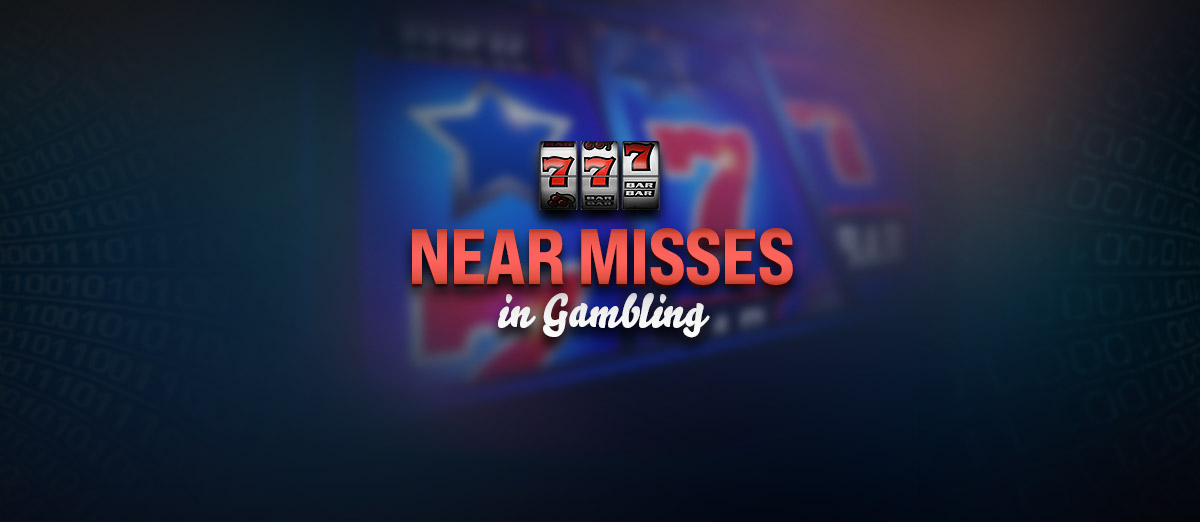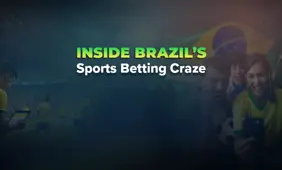Gambling Near-Misses – Illusion, Reality, and Theory

“I was that close!” (to a win) is a common and frequent saying or thought among gamblers that it became specific to gambling in general. To win in a game, so many times you needed 1 more or less point (as in craps, baccarat, or blackjack), 1 specific card (as in poker and other card games), 1 award symbol on a slots or scratch-card payline, 1 or 2 numbers on the lottery draw, and so on.
Such situations trigger for the gambler contradictory emotions—on the one hand, there is the sadness of missing a win, but on the other hand, there is hope for a win in the near future, given that the win was nearly missed. However, this latter emotion is actually the result of a fallacious belief, which I shall talk about in this article.
When the near-miss is taken by a gambler as an encouraging sign and fuels their decision to continue gambling, to chase the win that apparently was nearly missed, this near-miss effect is qualified in problem gambling as a cognitive distortion and recognized as a major risk factor for problem gambling behavior.
What Is a Near-Miss, and What Are the Types of Near-Misses?
A near-miss is roughly defined by experts as a failure that looks close to being successful. It is associated with an outcome that differs slightly from a winning one.
With the development of games, especially slots, distinctions have been made regarding the types of near-misses. Thus, we distinguish between two types of near-misses: a direct near-miss (associated only with the outcoming string or combination of numbers, symbols, and cards of the game, among others—e.g., what appears on a payline in slots) and an indirect near-miss (associated with the area a game displays together with the outcome—e.g., what appears adjacently above or below the payline in slots).

Another distinction is between near-misses by pure chance (i.e., chance near-misses) and artificial or engineered near-misses. This latter type is present in modern slots, where the pre-manipulation of the game’s parameters by the developer through specific techniques makes some combinations that look like near-misses occur with a certain frequency. Such pre-manipulation producing an artificial near-miss has its equivalent in scratch cards, in a flat form, where the award symbols are preprinted in clusters to create the near-miss sensation when uncovering them.
Combinatorial near-misses are those specific to games whose final outcomes are evaluated just as combinations of items and not through other amounted value except for the number of particular items (as in slots, lottery, bingo, card games, etc.), and cumulative near-misses are those specific to games whose final outcomes are evaluated through sums of values attached to the partial outcomes (as in blackjack, baccarat, and some gaming situations specific to dice games like craps and backgammon).
“Mathematizing” the Near-Miss
An abstract definition for a near-miss is in combinatorial terms:
Consider a game of chance and denote by O a final outcome, that is, the outcome not followed by another outcome in that game and on the basis of which the award is given if O matches a winning rule.
O is a combination, arrangement, finite string, or vector consisting of n partial outcomes O = ( e1, e2, ..., en), where ei are one-dimensional outcomes (items) in the form of symbols, cards, or numbers, depending on the game. For a given n-size winning outcome W as defined in the game’s rules, if W differs from O in only one element ei (O - W = {ei} in set-theoretic denotation), then the occurrence of O is said to be a near-miss of W. (The definition can be generalized further to have more than one partial outcome missed; for simplicity, we shall stay with the definition with one item missed).
As order does not count, consider en as the missing element from W. In reality, in the case of a real or illusory chronology of O, this situation is the most frustrating and emotional for the gambler.
The finite string S1 = ( e1, e2, ..., en-1) is that part of the outcome O that matches the winning outcome W, while S2 = (en) is that part that does not match. We can then represent the near-missed outcome as a bidimensional combination O = (S1, S2), where the matching part S1 is multidimensional and the nonmatching part S2 is one-dimensional.
This abstract definition reflects what the gambler actually does within the near-miss effect, namely, creating a mental representation of a split of the final outcome O in two parts, that is, the matching part S1 and the nonmatching part S2; without this split, there will be no near-miss as defined.
What Probabilities Tell Us about the Near-Miss
Let us see now what probabilities are involved in the near-miss as a probabilistic event. First, note that S1 and S2 may or may not be independent. For instance, in dice games or classical mechanical slots, they are independent since dice roll and reels spin independently of each other; in poker games, blackjack, and virtual-reel slots with RNG, they are not. The probabilities of either O, W, S1, or S2 as gaming events are defined and calculated in two probability fields characterized by the information available before the measured event occurs.
If S1 and S2 are independent, we have the following relations between these probabilities:
(1) P0 ( O ) = P0 ( S1 ) . P0 ( S2 ) as the probability of O, in the probability field of the information before S1 occurring [this is denoted by the o (original) with P0].
(2) P0 ( W ) = P0 ( S1 ) . P0 ( W - S1 ), as the probability of W, in the same probability field as above (the denotation in the last parenthesis is set-theoretic).
Now, right after S1 occurs (at the moment of the split, before S2 occurs):
(3), Ps ( O ) = Ps ( S2 ) = P0 ( S2 ) in the probability field of the information at the moment of the split [this is denoted by the s (split) with Ps ]. That information is the occurrence of S1.
(4), Ps ( W ) = Ps ( W - S1 ) = P0 ( W - S1 ) in the same probability field as right above.
By doing some algebraic operations with the relations (1) to (4), we get that P0 (W) = Ps ( W ) . P0 ( S1 ). If we take here S1 as a variable ( W is given per game rules and thus P0( W ) is constant, while Ps ( W ) depends on S1 ), we have that the product Ps ( W ) . P0 ( S1 ) is constant.
We come to a similar result if S1 and S2 are not independent (a case where conditional probabilities are involved).
This is all we need for a complete description of a near-miss in basic mathematical terms, and all that you have to remember if you did not follow the math is that the product of those two probabilities is constant.
Gambler‘s Measure and the Adequate Measure
“I was that close” expresses both an observation and an intention. The observation is that of being extremely close to a win. But what is “close,” and what is “that”? These can be answered in the combinatorial terms that define the near-miss: “close” is, for the gambler, a measure of the size of a combination, that is, in how many elements the outcome differed from the winning outcome. “That” is the numeric amount of that difference; we took 1 as the standard size of a near-miss.
Why is the gambler’s measure not right or relevant for the near-miss? This is because of the implicit intentional aspect of “I was that close,” saying in effect, “Therefore I will play again to be in that situation again, and perhaps next time I won’t miss.” The intentional aspect involves prediction under uncertainty, and the only rigorous measure available for uncertainty is probability; thus, we have to engage the probabilistic description in the definition of the near-miss.
Let us focus now on the intentional-predictive aspect, which exhibits a double prediction with effects: (P1) “I will be in this (near-miss) situation again” and (P2) “At that time (or another ‘next time’), I will win (W).”
In our probability terms, the realization of prediction P1 depends on P0(S1), or in frequentist terms, the higher this probability, the higher the frequency of S1. The realization of prediction P2 depends on Ps(W), and the two probabilities are related through their product being constant, as we saw in the previous section.
Of course, the optimism is expressed through the confidence in the realization of both P1 and P2. However, since the product of the probabilities of P1 and P2 is constant, the higher the one is, the lower the other. Any strong confidence in one prediction should thus weaken confidence in the other, and the overall confidence should not be influenced by either of the two alone. Moreover, as regards the actual numerical probabilities, it is well-known that they are usually both extremely low in most games of chance.
Seeing the Difference Concretely
Just to provide illustrative examples, let us take one from the lottery and one from blackjack.
Consider a one-line ticket with 6 numbers in the 6/49 lottery and the winning outcome having 4 winning numbers. Let us assume you had 3 of them already hit in the first 5 numbers drawn and are awaiting the 6th to be drawn. The probability of hitting 3 winning numbers within the first 5 drawn is 0.004961, which is about 0.5%, as the probability P0(S1). The conditional probability of hitting the 6th drawn number is 0.06818 (about 6.8%—a big one!), that is, Ps(W). However, their product is 0.000338; that is almost 0%! It does not look like a near-miss anymore, does it?
Consider a one-deck blackjack situation in which you are the only player, and you achieved 19 points from the first 2 cards, the dealer’s card is not A or 2, and you expect a blackjack with the next card. The probability of achieving the 19 points with the first 2 cards is 6.03318% as P0(S1), while that of getting A or 2 with the 3rd card is then 8.16326% as Ps(W). Their product is 0.4925%. Again, not that “near”! But anyway, this is our “near” and not the gambler’s, whose “near” is actually evaluated at the moment of the split.
Our context of the near-miss effect thus reveals a special form of conjunction fallacy, which is the cognitive distortion in which the person overestimates the probability of the conjunction of events.
For What All That Mathematical Stuff?
Let us try now to take a neutral stance to overview our mathematical description of the near-miss. This description reflected the near-miss and the near-miss effect from the standpoint of the gambler affected by it, as a direct consequence of splitting the outcome into a matching and nonmatching part. However, in a standard mathematical model, the whole outcome O is considered, with no split, either merely combinatorial or chronological.
There is no mathematical reason for treating S1 and S2 separately with respect to any of the functions and goals of a mathematical model (representation, prediction, measurements, optimization, etc.). O is an element of a mathematical structure having the same status as any other outcome, winning or not. In a probabilistic model, O is just an elementary event in the sample space of that game and has no other content or interpretation given by any split of it. Event O has a certain a priori probability of occurrence P(O), which is the same regardless of any split of O, and is the only probability that counts toward any theoretical or practical aim since O is a final outcome. Then why would this mathematical description be of any importance?
In overcoming the near-miss effect, obviously, the straightforward move is to make the gambler drop that split of the outcome combination in two sequences. In this representation, there is no near-miss or near-miss effect. A cognitive intervention based on the “no-split” representation might or might not be successful. The near-miss effect has—like all the other cognitive distortions—neurological and psychological causes that may prevail over cognitive-educational assets. Our brain makes associations all the time, and some of them trigger emotions that many times potentiate fallacious beliefs.
But in the case of the near-miss, there is always a positive alternative with regard to correction: If the “no-split” representation does not work for the gambler, there remains the mathematical description showing that “that close” in a gambler’s metric is actually “thus far” in probability measurement, and the near-miss is just a miss; in other words, when frequent near-misses occur, the gambler is not constantly missing but losing.
References
Bărboianu, C. (2019). The epistemology of the near miss and its potential contribution in the prevention and treatment of problem-gambling. Journal of Gambling Studies, 35, 1063–1078.
Bărboianu, C. (2022). Understanding your game: a mathematician’s advice for rational and safe gambling. Târgu Jiu: PhilScience Press.
Griffiths, M. (1991). Psychobiology of the near-miss in fruit machine gambling. The Journal of Psychology, 125(3), 347–357.
Stange, M., Graydon, C., & Dixon, M. J. (2016). “I was that close”: investigating players’ reactions to losses, wins, and near-misses on scratch cards. Journal of Gambling Studies, 32(1), 187–203.





Review this Blog
Leave a Comment
User Comments
comments for Gambling Near-Misses – Illusion, Reality, and Theory